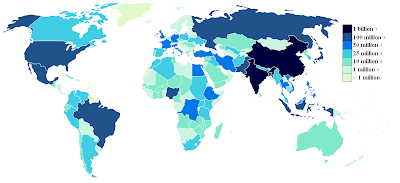A post on Planet Green recently highlighted the use of praying mantis as an alternative to pesticides.
This concept is not exactly new in the agricultural industry but has taken a back seat to pesticide usage. Reason being? Pesticides are much cheaper and easier to deploy than natural pests. Its just that simple. Agriculture in essence is a business and businesses talk about money. The less time you spend on the solution, the more monetary returns you get.
Now this post brought back some hypothesis which I made up back in 2004 when the tsunami hit Malaysia. We have natural predators to control pest population i.e. praying mantis for aphids, owls for rats but what about humans? What is controlling the human population? The answer is simple. Nature.
Map courtesy of Wikipedia.
The human population has been growing exponentially ever since mankind was brought to life. Currently we have hit 6.6 billion with most of the concentration in China, India, USA and Indonesia in that order (globalhealtfacts.org). With the unexpected population boom, the basic demands for living like proper shelter and sanitization are getting harder to meet. As a result, the immune system of the population drops and viruses jump from their animal hosts to humans. Cases like the AIDS and SARS virus are the exact representation of this state.
Is this a classic example of uncontrolled population? I would believe so. The population growth of these countries have overshot their development, leading to unequal wealth distribution which is mainly concentrated in the economic regions. What happens to the people outside this region? They are forced to live in inhumane conditions; tight crammed living spaces coupled with unhygienic food and water supplies thereby leading to the immunity disasters mentioned above.
Now imagine if you were a cattle rancher and your cattle was infected with some deadly disease, leaving half the herd dead while the other half awaiting judgment. What would you do? I'd say burn 'em all, cattle n' ranch altogether. This way you eliminate the source of the disease and the carriers itself.
Cruel? You bet. Thats the exact approach Mother Nature takes to problematic populations. Let me list down a few examples of natures wrath for the past 10 years for your reference. (Disasters sourced from cbcnew.ca)
Oct. 26-Nov. 4, 1998. Hurricane Mitch was the deadliest hurricane to hit the Americas. It killed 11,000 in Honduras and Nicaragua and left 2.5 million homeless.
Dec. 26, 2003. An earthquake devastated the ancient city of Bam, in central Iran, leaving between 31,000 and 43,000 people dead.
Oct. 8, 2005. At least 80,000 people were killed and three million left homeless after a quake struck the mountaineous Kashmir district in Pakistan.
And just recently on May 3, 2008 Cyclone Nargis, swept along by winds that exceeded 190 kmh and waves six metres high struck the Burmese peninsula and may have left as many as 100,000 dead, according to U.S. estimates.
The facts alone make a pretty damn good conclusion. Nature herself is controlling the human population by sending natural disasters to clean up the mess we have made. How else did she get rid of the highly inefficient dinosaurs? Some might say that all this was the act of God but its really up to you to decide. As for me, I'm sticking with this hypothesis. I'm not quite sure if there are any laws or theories out there which have already cited this hypothesis of mine. If there is, do let me know.
Happy Mother's Day Mother Nature!




2 comments:
While mother earth is busy weeding out 'excess' humans, the moon and mars are trying to convince ppl to migrate over there.
well said!! LOL!!
Post a Comment